A number of you wrote with questions about the techniques Kazuo Onuma uses to create his mini-bonsai last week. Here are some answers!
Chojubai
Onuma grows chojubai by starting young cuttings in round, plastic containers. After several years, he removes the containers and lets the soil – red lava in this case – fall away over time.
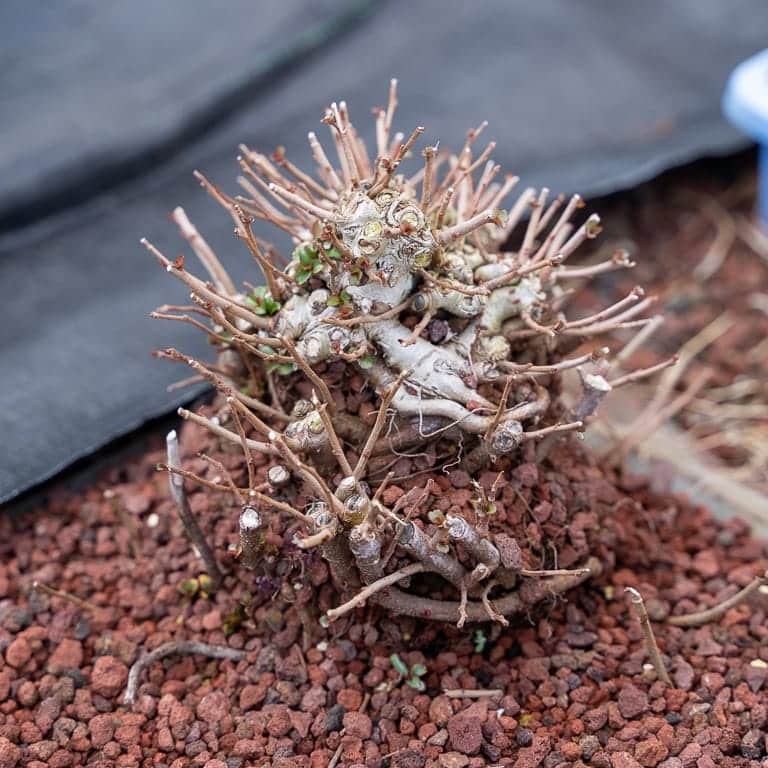
Chojubai in development
By using round plastic pots, the roots take a circular form. As the soil falls away and exposes the roots to sunlight, new shoots develop that become the tree’s primary branches.
As for the soil, Onuma prefers red lava rock (scoria) for every tree in the garden. Sometimes sharp sand was mixed in, but most of the soil was straight lava rock.
Once Onuma’s chojubai develop great trunks, he places them in colanders. As the colanders fill with roots, he stacks additional colanders or ceramic containers to give the roots plenty of space to grow. By encouraging the sacrificial roots to grow downward, the roots near the trunk remain small and in scale with the trunk.
If a small tree is planted directly into a larger container, the roots near the trunk can become coarse – an undesired result when creating small bonsai.
A ring of drainage screen (see below) is a great first “container” as it can be made in any shape or size to suit the development goals of the bonsai.
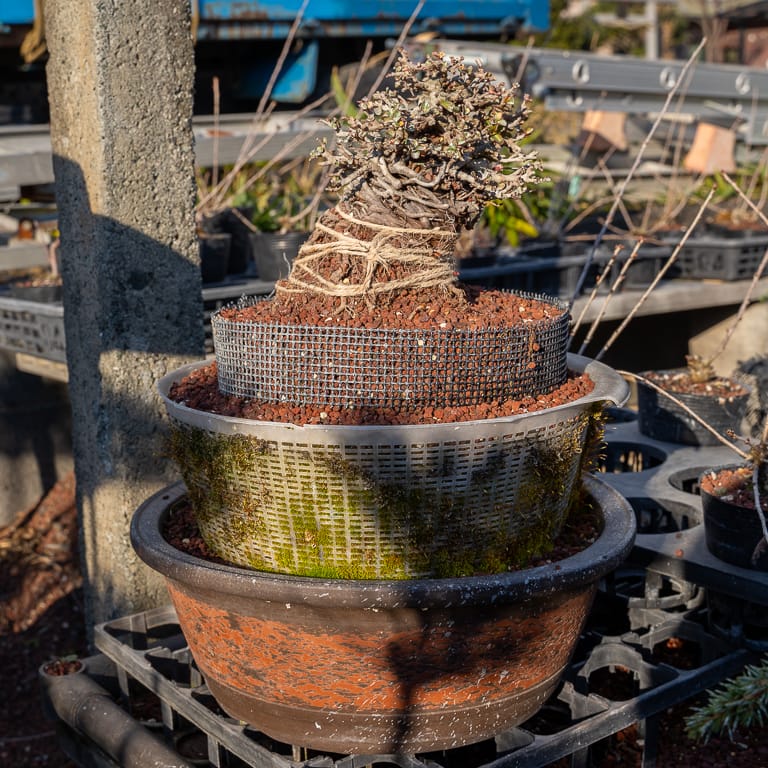
Chojubai in drainage screen above a colander above a ceramic pot
Juniper
Onuma’s junipers follow an interesting path. The first step is straightforward – he wires the trees into fantastical shapes.
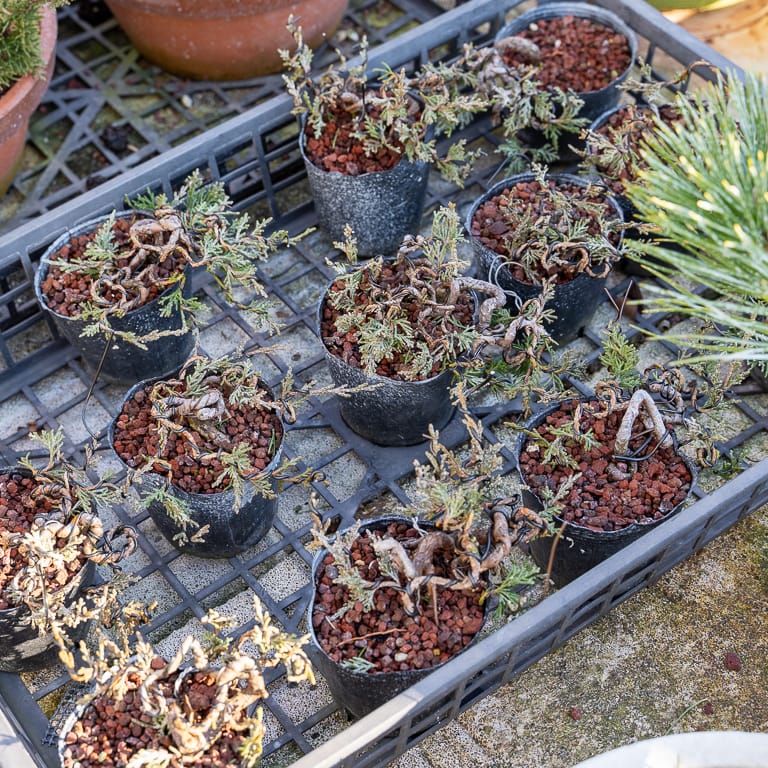
Wired junipers
The trees grow larger over time (thanks to double and triple colanders) but don’t sport interior branches as Onuma keeps the bulk of foliage at the ends of the branches.
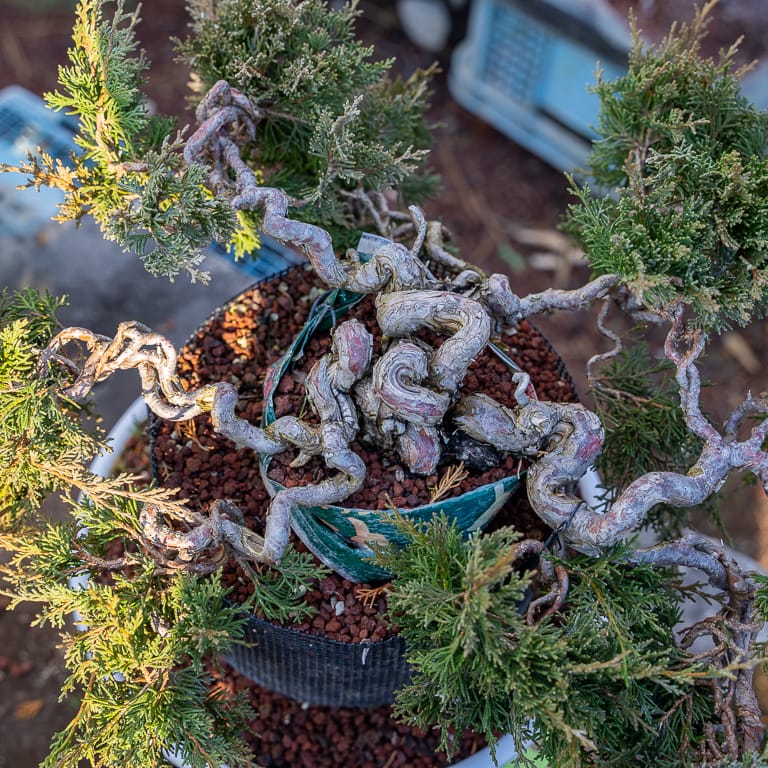
Twisty juniper branches
When the trees reach this stage, Onuma applies little wire. Instead, he braids the branches together (you can see this in the above photo towards the ends of the branches).
Braiding branches is faster than wiring and creates natural movement. Over time, the smaller branches are removed leaving the larger branches behind.
Instead of creating primary branches from these twisty starts, Onuma layers them all to create even more junipers!
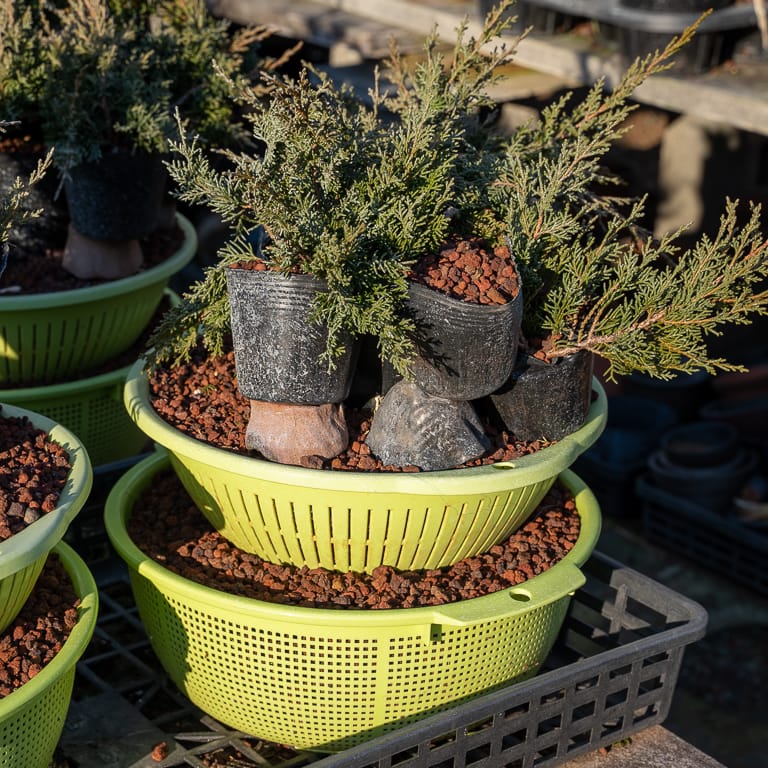
Layering twisty branches
By taking this approach, Onuma wastes nothing as even the sacrifice branches become new trees.
Japanese Maple
Onuma’s maples follow a fairly traditional development approach: let branches run for a year or two before removing them and repeating the process the following year. Here’s what this looks like.
Below is a young Japanese maple. You can see where the trunk was cut one year ago (about one inch above the ground) as the cut encouraged four new shoots to develop.
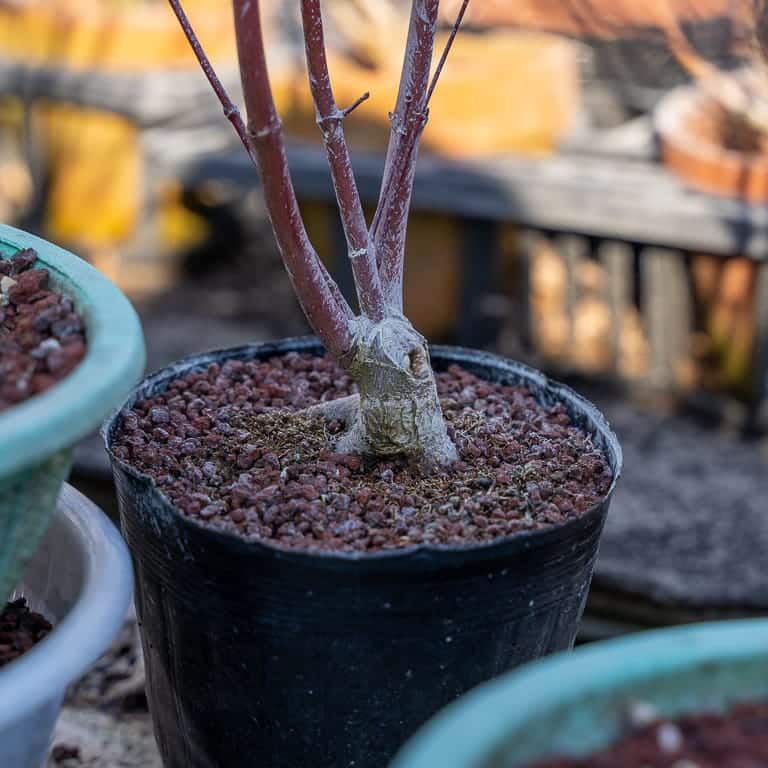
Young Japanese maple
After several years of this pruning, the lower trunk increases in size. Here’s a tree with a broad lower trunk but no significant upper trunk.
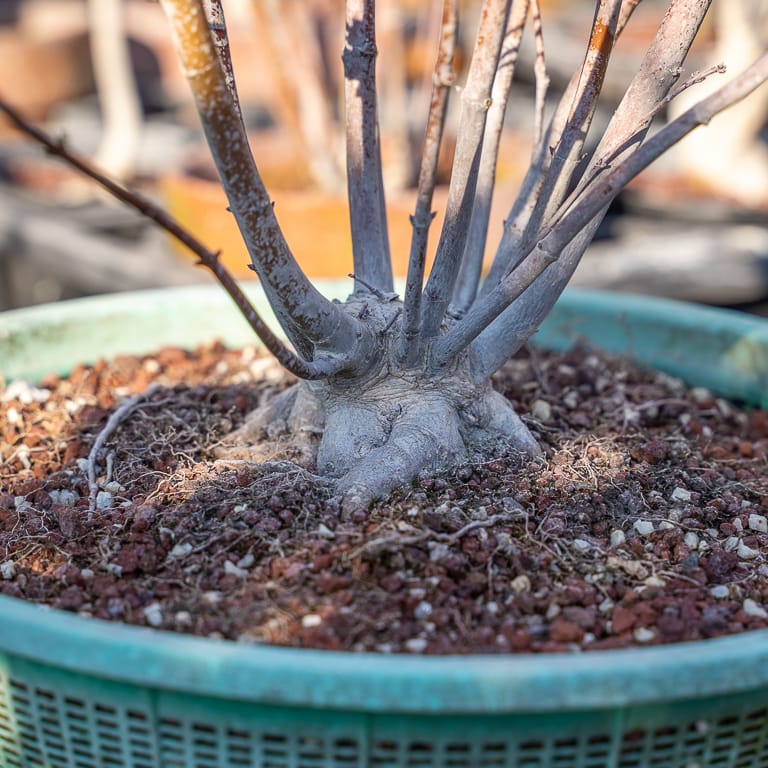
The lower trunk begins to take shape
After repeating this approach for several years, Onuma ends up with trees that look like this.
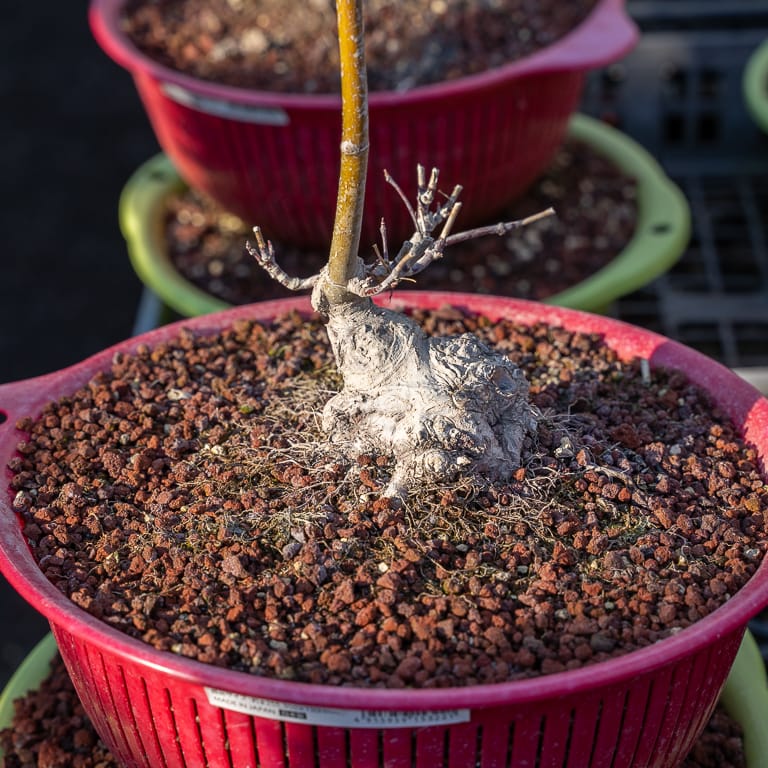
Maple with a single sacrifice branch
When most of the trunk and primary branches are in place, Onuma keeps a single sacrifice branch that he’ll eventually air-layer to create yet another tree. Here’s a maple nearing the end of the trunk development phase.
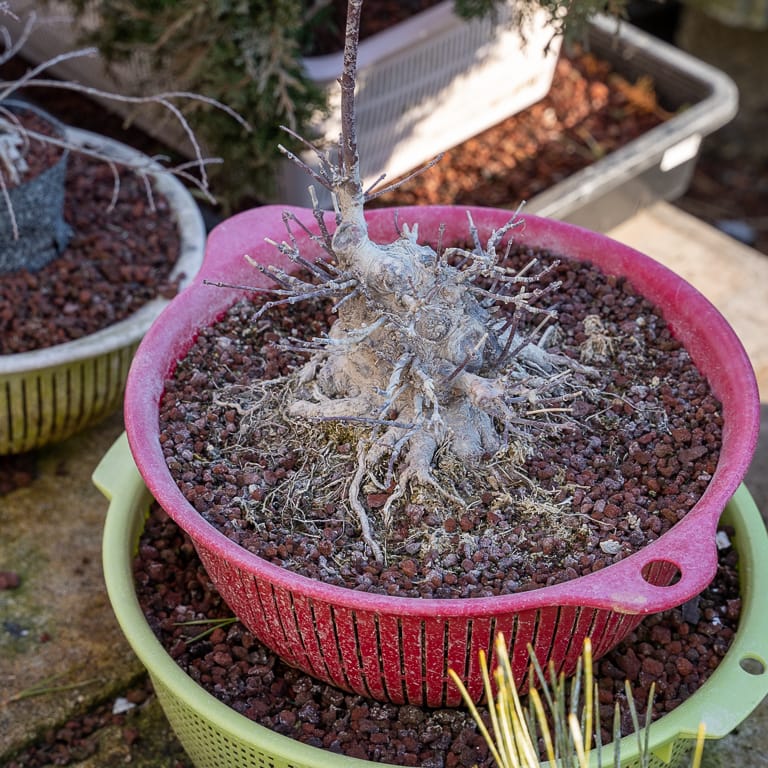
Relatively mature Japanese maple
The scars on the trunk above reveal the locations of the sacrifice branches used to form the trunk. I expect many will heal well, but I don’t know that all of the scars will vanish with time.
Onuma follows a similar approach with his trident maples from start to finish.
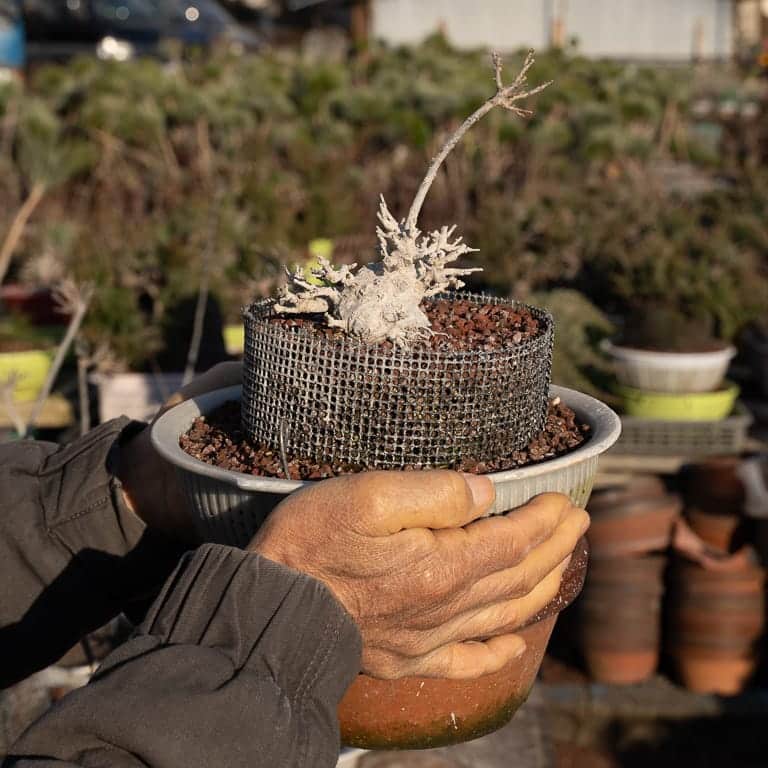
Relatively mature trident maple
This covers most of what I picked up at Onuma’s garden. If you can think of additional questions, feel free to ask them in the comments below!
Overview of Bonsai Development Techniques Published by American Bonsai Society
The current issue of Bonsai: Journal of the American Bonsai Society, features an article of mine that covers the basics of bonsai development from seed, layer, or cutting.
The article, “Making Trees from the Ground Up” (pages 6-19), identifies strategies for avoiding common problems that can prevent trees from taking the shape you want as they develop.
The best way to get a copy is to join the American Bonsai Society – a subscription to the journal is a key benefit of joining. Single issues will likely be available from the ABS bookstore in coming months.
As coincidence would have it, the issue features an image from The Little Book of Bonsai on the cover.
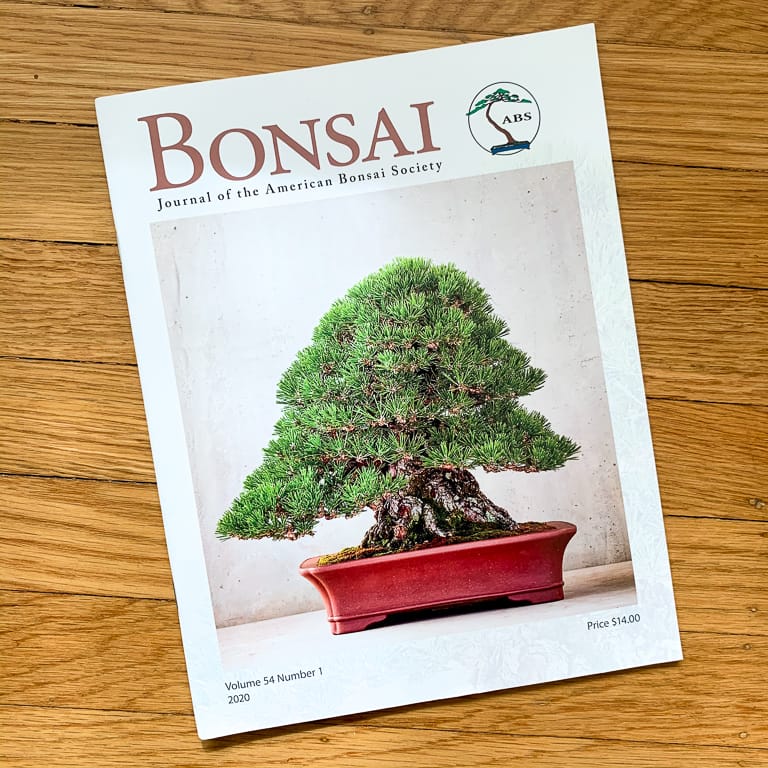
Japanese black pine – photo courtesy The Little Book of Bonsai
Subscribe to Bonsai Tonight
New Posts Delivered Every Tuesday and Friday
Gary says
GREAT info Jonas!
THANKS!!!
Gary says
One quick question.
So basically, Onuma is never working the roots. He’s just letting them grow deeper and deeper down into the next colander. Is that correct?
Jonas Dupuich says
Good question, I didn’t ask how often he touches the roots. My guess is not much. If the surface roots are in good shape before the rapid development begins there isn’t much need to adjust them until the trunk takes shape. There’s no need to work with the lower roots as they’ll all come off in time.
David Crone says
Thank you so much! This was very insightful.
Thomas says
Congratulations on getting your bonsai on the journal’s cover!
Jonas Dupuich says
Thanks, Thomas!
Andy Johnson says
That’s really interesting, laying one colander on top of another. I’ve got to try that!
Quick question about the Chojubai; does Onuma grow the cuttings straight in the red lava? Or something else first and then transplant them?
As ever, many thanks for posting these really informative pieces of information, Jonas!
Andy
Jonas Dupuich says
Good question Andy, I don’t know – I didn’t see any recent cuttings when I was there. He might just use the lava rock as it works for everything else!
Robert Potts says
What is his watering routine like, given that he is using just lava?
Jonas Dupuich says
Hi Robert – I assume he waters a lot, but one benefit of the multiple colanders is that there’s a lot of soil there. The pores in the lava also hold a lot of water as they’re connected to each other.
Peter Grisdale says
Wow fascinating, thanks for sharing ! You don’t see stuff like this in books or see pro’s teaching this stuff 👍🏻👍🏻
Interesting to see he only grows in red lava too ! I’ve heard red lava has various minerals in it that are beneficial to trees like iron for example.
Have to say I really enjoy your articles and get exited when I see an email with a new one 😂🤣
Jonas Dupuich says
Thanks Peter – I really appreciate it!
Joshua diaz says
Hello Jonas,
Great post! I was wondering if you could elaborate a little more on the way he grows his needle juniper and what he is trying to achieve with them. Did he have some end result of them. Thank you.
Best,
Joshua
Jonas Dupuich says
Hi Joshua! You can see the result of his needle-juniper growing techniques in the previous post: https://bonsaitonight.com/2020/02/28/onumas-mini-sized-bonsai/
As for the process, he cut back the top of the tree hard and wired the young branches while letting the lower branches run 12″ before cutting back.
Ben Goodman says
Love the posts from his garden! Does he usually cut the maples back just before they bud out (around now in zone 7)? I thought folks did it right after they dropped leaves in the fall…
Jonas Dupuich says
Good question Ben – I don’t know when he prunes. We didn’t talk much about timing. Considering that his maples still had long branches, I’d guess he prunes during the growing season.
Pedro says
Thank you very much Jonas for your work on the blog, do you know if when he wants to pass it to a pot of bonsai he does it progressively demonizing the plastic containers one by one or removes them all at once?
Pedro says
Sorry, demonizing=disassembling
Jonas Dupuich says
Hi Pedro! It looked like he removed the container all at once as I didn’t see any partial containers in the garden.
Robert says
incredible.
Rajeev Vaidya says
Thanks for the insights into developing heavy trunks on
these species
Jonas Dupuich says
Thanks Rajeev!
Jeff says
i was like a conspiracy theorist studying his ig account for months trying to figure out what the hell was going on. u have no idea how amazing this post is for me. god bless u sir!
Jonas Dupuich says
Thanks Jeff, am happy to hear it! Feel free to let me know if you come across any other growers in Japan and I’ll see what I can do!
Michael Westervelt says
Jonas, thank you for posting this fascinating development article.
You mentioned Onuma layers off the juniper branch ends(very thrifty!)
any idea what subsequently happens with the trunk base, wait for back budding, grafting, etc?
Jonas Dupuich says
Great question Michael – it looked like he jinned most of the stubs from the layered branches and was planning to use whatever was left to create the canopy of the original tree. I didn’t see any refined junipers around so it looked like they were all still in progress. Will have to check back with him in a year or two and see how everything looks!